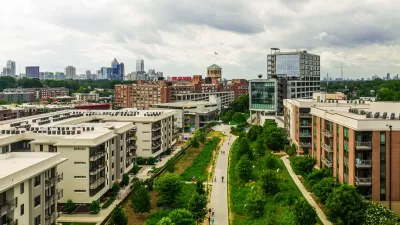Eric Jaffe reports on the growing use of "health impact assessments" (HIA), which are used in a similar fashion to environmental reviews, to determine the public health side effects of major projects.
Already in frequent use in Europe and Canada, "[a]n HIA, like an environmental review, evaluates the potential effects a major planning project might have on the public health of a surrounding community, and recommends certain actions needed to mitigate - or, in the case of health benefits, accelerate - those impacts," writes Jaffe.
As the effects of land use on public health become more prominent in the minds of planners, citizens, and officials, HIAs are a valuable tool in elucidating the direct connection between planning and design decisions and health outcomes. As an example, Jaffe explores the HIA completed for Atlanta's BeltLine project, which seeks to transform 22 miles of abandoned railroad near downtown Atlanta into parks, trails, transit, and development.
"Conducting the HIA required an interdisciplinary team of health professionals and planners to examine the BeltLine plans, compile all sorts of data on the community in the project's impact area, and compare these findings with existing public health literature. The HIA focused on several broad categories of health, from physical activity to access and equity to safety, and its 72 recommendations range from the broad and basic (Atlanta should speed up the BeltLine timeline) to the painfully specific (residential units should be at least 600 feet from high-volume roads to reduce impact of particulate matter)."
FULL STORY: How to Measure a Project's Health

Planetizen Federal Action Tracker
A weekly monitor of how Trump’s orders and actions are impacting planners and planning in America.

San Francisco's School District Spent $105M To Build Affordable Housing for Teachers — And That's Just the Beginning
SFUSD joins a growing list of school districts using their land holdings to address housing affordability challenges faced by their own employees.

The Tiny, Adorable $7,000 Car Turning Japan Onto EVs
The single seat Mibot charges from a regular plug as quickly as an iPad, and is about half the price of an average EV.

Trump Approves Futuristic Automated Texas-Mexico Cargo Corridor
The project could remove tens of thousands of commercial trucks from roadways.

Austin's First Single Stair Apartment Building is Officially Underway
Eliminating the requirement for two staircases in multi-story residential buildings lets developers use smaller lots and more flexible designs to create denser housing.

Atlanta Bus System Redesign Will Nearly Triple Access
MARTA's Next Gen Bus Network will retool over 100 bus routes, expand frequent service.
Urban Design for Planners 1: Software Tools
This six-course series explores essential urban design concepts using open source software and equips planners with the tools they need to participate fully in the urban design process.
Planning for Universal Design
Learn the tools for implementing Universal Design in planning regulations.
Smith Gee Studio
City of Charlotte
City of Camden Redevelopment Agency
City of Astoria
Transportation Research & Education Center (TREC) at Portland State University
City of Camden Redevelopment Agency
Municipality of Princeton (NJ)





























